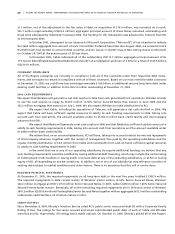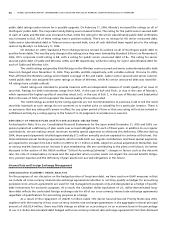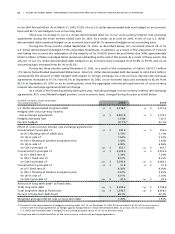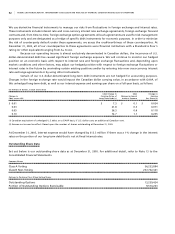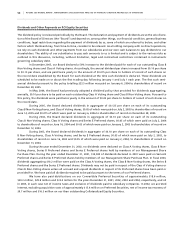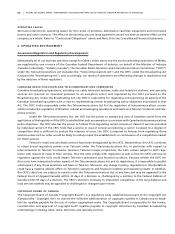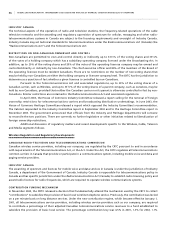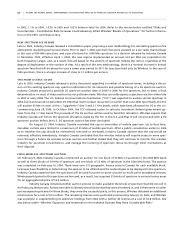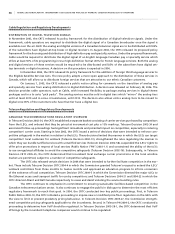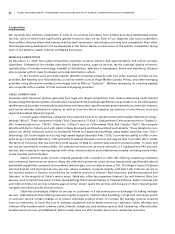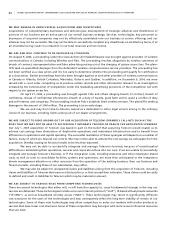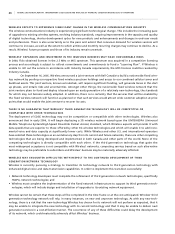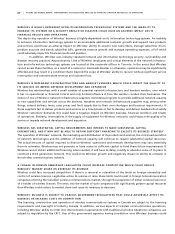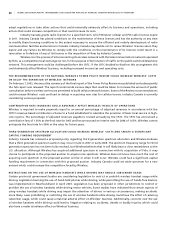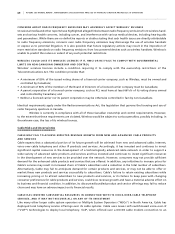Rogers 2005 Annual Report Download - page 63
Download and view the complete annual report
Please find page 63 of the 2005 Rogers annual report below. You can navigate through the pages in the report by either clicking on the pages listed below, or by using the keyword search tool below to find specific information within the annual report.
59 ROGERS 2005 ANNUAL REPORT . MANAGEMENT’S DISCUSSION AND ANALYSIS OF FINANCIAL CONDITION AND RESULTS OF OPERATIONS
In October 2005, the CRTC released its fifth annual report to Cabinet on the state of competition in the Canadian
telecommunications sector. This is pursuant to the CRTC’s mandate to assess and report on the state of competition in the
industry on an annual basis. The CRTC’s conclusion is that local competition has increased since 2000, although competitors
have not yet generally gained the same level of market share in the local markets as they have in the long distance,
Internet or data and private line markets. They have, however, made inroads in both the business and residential
urban markets in several major centres.
On February 3, 2005, the CRTC released Telecom Decision CRTC 2005-6 with respect to the ILECs’ Competitive
Digital Network services (“CDN”). The decision concluded the process that was initiated by the second Price Cap decision.
In Decision 2005-6, the CRTC set the terms and conditions, as well as the rates that competitors will pay the incumbent
telephone companies for digital network services they rely on to provide services to their customers. In arriving at the
decision, the Commission took into account: a) the competitors’ reliance on the telephone companies’ network facili-
ties and services; b) the competitive supply that exists in the marketplace; c) the constraints competitors face in building
their own networks; and d) the state of competition in the local market. Rates for access to low-speed services, which
are legacy copper-based, were set at cost plus 15%, while rates for high-speed services, which are generally fibre-based
and easier to replicate, were reduced from their prior market level to cost plus a margin above 15%. The CRTC found that
competitors still rely heavily on the facilities of the telephone companies and that by reducing the prices for underlying
facilities, competitors will be able to offer services to more customers and in more regions, and that growth in their
customer base and revenues will facilitate the expansion of their own networks.
CA N A DI A N R EG U L AT I ON OF I NT E RN A TI O N AL TR A FFI C
On January 1, 1999, the CRTC instituted a new regulatory regime for international telecommunications. Under this
regime, any carrier that transports international telecommunications traffic over a Canadian border requires a Class
A licence from the CRTC. Any domestic carrier that originates or terminates, but does not carry over the border, inter-
national telecommunications traffic requires a Class B licence from the CRTC. Both types of licencees are subject to
minimal reporting requirements and are prevented from acting in an anti-competitive manner. Telecom obtained all
such licences.
Media Regulation and Regulatory Developments
The CRTC has announced a review of the Commercial Radio Policy in the first half of 2006. The review will explore a
number of industry-related issues, including Canadian content levels and Canadian talent development contributions.
In preparation for the review, Media is working with various industry groups and associations on a number of industry-
related issues and concerns.
The CRTC has released its digital television policy, covering issues such as priority carriage and simultaneous
substitution. Media believes that the CRTC policy provides an effective framework for continued growth and develop-
ment of digital television broadcasting in Canada. CRTC processes have also been conducted to develop policy frameworks
for the licensing and distribution of high-definition pay and specialty services as well as the transition or migration of
specialty services from analog to digital. A CRTC decision regarding digital migration is expected in 2006.
The Copyright Board has released its decision for SOCAN (Society of Composers, Authors and Music Publishers of
Canada) and NRCC (Neighbouring Rights Collective Society) tariffs affecting commercial radio broadcasters. Retroactive
to January 2003, the royalty rates for both tariffs have increased significantly. The new rates imposed by the Board will
impact the results of Media’s radio operations.
On June 16, 2005, the CRTC issued decisions approving three new subscription radio services. These decisions
were appealed to the Federal Cabinet and these appeals were not successful. Two of the services are satellite-delivered,
partnering with established and well-financed satellite radio operators in the U.S. These new subscription services offer
a wide variety of music and spoken word programming channels, and will compete for audiences with the Media radio
stations in markets across Canada. However, given that these new services are also prohibited from carrying local pro-
gramming content and selling local advertising, the Media radio stations expect to sustain their competitive advantage
as local broadcasters in their local markets.


